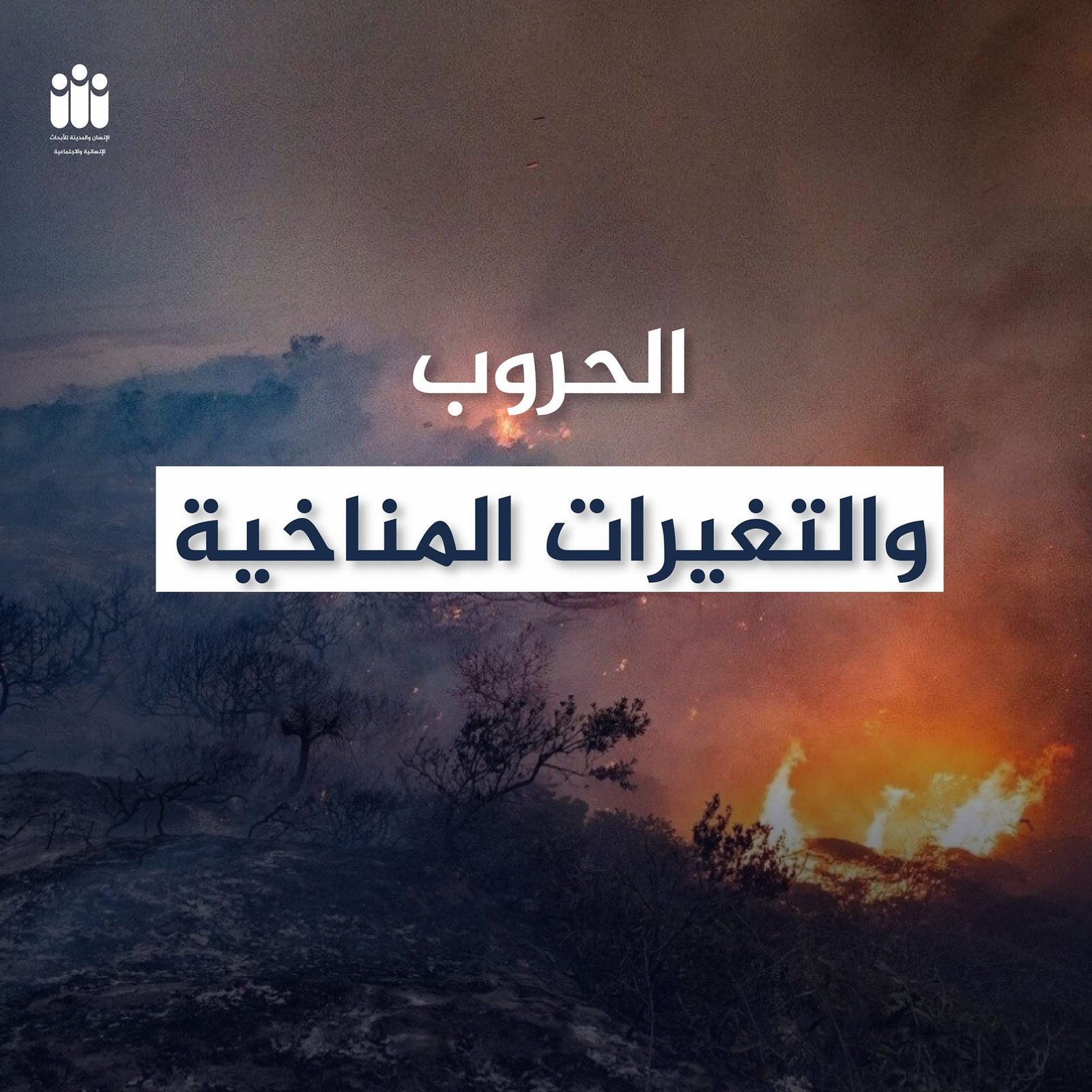Since the dawn of history, war have been part of the human experience. When we think of war, scenes of bloodshed, hideous corpses, demolition of homes, dismantling families and leaving homelands come to mind. The environment is one of the unknown and silent victims of wars. Habitat destruction may ruin the ecological system at large, encompassing air pollution, land degradation, biodiversity loss, harm to marine life. These impacts may extend to tens of years affecting human lives as well as contributing to climate change.
At a time when scientists, thinkers and various concerned authorities dealing with climate changes struggle to maintain normal temperature rates and work to stop its rise, we see new wars added to the list, such as the conflict between Russia and Ukraine, whose consequences are expected to be catastrophic on climate changes due to the energy crisis it generates.
The United States, Saudi Arabia and Russia are among the top three countries in the fuel trade, and Russia is the first source of natural gas to Europe. Due to the ongoing conflict between Russia and the West, European energy security is under threat from Putin. The Russian president refused to accept the cost of natural gas either in US dollars or in Euros, and insisted on receiving in his country’s currency, the Russian ruble. The United States and Europe have begun stockpiling their coal as a precaution in case Russia refuses to sell them natural gas or decides to stop providing financial support to ease the pressure of the war on Ukraine. Germany and some neighboring countries have already temporarily returned to relying on coal until the crisis is resolved or alternative sources of natural gas are found. The problem lies in not knowing the actual length of this temporary period, as it may extend to several years. It is also expected that this will not only be limited to Germany and some neighboring countries, but will include all of Europe, after they were on the path of the complete banning of the use of coal by 2038[1]. The situation was further complicated by the sabotage actions against the two gas pipelines: “Nord Stream 1” which started its work in 2011 and is able to transport 170 million cubic meters per day of gas, and “Nord Stream 2” which was supposed to transport 55 billion cubic meters of gas but was discontinued by Germany in response to the Russian war on Ukraine[2]. Given the damage to the two gas lines, it is expected that repairs will not be completed before six months at best, which confirms the fact that the upcoming European winter will be the most difficult with high gas prices and scarcity, and consequently high prices of electricity needed for heating, which brings us back to the use of wood as a heating source; thus, logging huge numbers of trees for this purpose.
The problem of returning to coal use is not only in extraction, manufacturing, transportation or trade, but rather lies in the process of its combustion. It is the largest contributor to the increase in carbon dioxide in the atmosphere. Coal-fired electricity generation produces nearly twice as much greenhouse gases per kilowatt as compared to natural gas generation[3]. If this shift in energy sources occurs, it will jeopardize attempts to maintain global warming (by only 1.5°C) and existing efforts to try to reduce carbon dioxide concentrations (to 350ppm) at serious risk. During wars and armed attacks, green spaces are destroyed or burnt; this leads to a rise in carbon dioxide in the atmosphere, in addition to destroying the natural habitats of animals, birds and other living creatures that use forests and green spaces as their environment. As green spaces are destroyed, it becomes more and more difficult to get rid of carbon dioxide and it remains in the atmosphere for a longer time. Militaries consume huge amounts of fossil fuels, which directly contribute to global warming. For example, if the US army were a country, it would have ranked 48th in terms of total emissions around the world[4]. As most countries invest more money in their armies, the use of fossil fuels is rising, with or without conflict. And while the military (even without engaging in wars) contributes to climate change, active warfare increases this contribution exponentially. For example, the United States and allied forces have launched more than 337,000 bombs and missiles at other countries over the past 20 years[5]. Airplanes used to load and transport these weapons burn about 16 liters of gasoline per kilometer[6]. With the explosion of each bomb, the percentage of carbon dioxide in the atmosphere increases, in addition to destroying the soil and green spaces, which are among the most important sinks of carbon dioxide. The so-called US war on terrorism has produced 1.2 billion metric tons of greenhouse gases in the atmosphere, with more global warming effects than the annual emissions of 257 million cars[7].
Drinking water infrastructure is severely damaged during wars, which affects the availability of water, as is the case in Syria after 10 years of war[9], in addition to the pollution of water bodies adjacent to military camps resulting from the dumping of waste of all kinds, the most dangerous of which is the fuel waste or chemicals used in the maintenance of warships[10]. In addition to nuclear and hydrogen bombs weapons tests conducted by countries such as the USA, Russia and North Korea[11], which can lead to several negative effects such as soil and groundwater pollution, and marine pollution with chemicals and minerals that may include mercury, iron and plutonium. This could also have severe consequences for plants and marine organisms in these areas, leading to disruptions in the food chain[12].
The health and safety of natural resources, now and in the future, is one of the most important sustainable development goals in light of the climate changes, which affect soil fertility as a result of drought resulting from high temperatures and their negative impact on the cultivation of crops in various regions, in addition to the continuous decrease of water resources due to the increase in the rate of evaporation of water bodies, and the increase in the rate of rainfall with different distribution. These negative effects of climate change pose a new global crisis, which is the threat to international food security. Due to the absence of control and the complete disregard for the safe protocol for the disposal of toxins or harmful chemicals after World War II, chemical weapons residues, such as mustard gas and arsenic toxins, were packed into barrels and disposed directly into the ocean, despite the danger to marine organisms and humans in the case of barrels’ decomposition and the exposure of water to toxic substances[13]. Sea and ocean pollution mean destroying the planet’s opportunity to reduce the global warming and climate change crisis; for seas and oceans are the largest sink of carbon dioxide due to the presence of phytoplankton, which are microorganisms that work to get rid of carbon dioxide through photosynthesis to obtain food.
Natural resources of occupied countries are always the first factor in the outbreak of wars; they are a source of temptation for the aggressors. Colonial countries are heading to countries richer in natural resources, the most important of which is oil, in order to seize them. Hence, France established colonies in Africa. Even after Algeria declared its independence from France in 1962, the power over its natural resources is still in the hands of the colonial state, which permits the use of dangerous and environmentally harmful mining methods for its companies outside its lands. For instance, allowing the use of water fracturing technology for French companies exploring shale gas, which is banned in France, in other countries by French Minister of Foreign Affairs Laurent Fabius in 2014[14].
Wars are expected to increase in the coming years due to the impact of climate change on natural resources of most countries. But, if wars continue to erupt and warnings of the danger of climate change are ignored, the efforts made to reduce emissions by switching to clean energy and others will be futile. Surviving the threat of climate change is the only factor that must unite the whole world now to work together and find solutions. The effects of climate change will not differentiate between rich and poor or strong and weak countries; it will hit everyone to varying degrees. Climate change may have some positives values: uniting nations and bringing peace.
Footnotes:
[1] “Europe’s turn back to coal a ‘temporary’ measure in response to Russian gas cuts”. CBC News. Available at: https://bit.ly/3eCFOo7. Last retrieved on: 07/10/2022
[2] “Fuites sur Nord Stream: l’UE promet la “réponse la plus ferme” à ce “sabotage”” France24. Available at: https://bit.ly/3CYUxSK. Last retrieved on: 10/10/2022.
[3] “Coal and Air Pollution”. Union of Concerned Scientists. Available at: https://www.ucsusa.org/resources/coal-and-air-pollution. Last retrieved: 07/10/2022
[4] “How War Impacts Climate Change and the Environment”. Global Citizen, 2022. Available at: https://bit.ly/3CWQ5VI. Last retrieved: 11/07/2022.
[5] “The U.S. Drops an Average of 46 Bombs a Day: Why Should the World See Us as a Force for Peace?”. Salon, 2022 Available at: https://bit.ly/3F8DrVa Last retrieved: 11/07/2022.
[6] “How War Impacts Climate Change and the Environment”. Global Citizen, 2022. Available at: https://bit.ly/3Tqj09W. Last retrieved: 11/07/2022
[7] “Pentagon Fuel Use, Climate Change and the Costs of War”. The Costs of War, 2022. Available at: https://watson.brown.edu/costsofwar/papers/ClimateChangeandCostofWar. Last retrieved: 11/07/2022
[8] “Environmental Impacts of Wars: The Irreversible Damage”, 2022. Available at: https://newsonair.com/2022/03/03/environmental-impacts-of-wars-the-irreversible-damage/. Last retrieved: 05/07/2022
[9] “Syria Water Crisis: Up to 40% Less Drinking Water After 10 Years of War”, 2021. Available at: https://bit.ly/3Vx00Zq. Last retrieved: 06/07/2022
[10] Lawrence, Michael J. et al. “The Effects of Modern War and Military Activities on Biodiversity and the Environment”, Environmental Reviews, vol 23, no. 4, Canadian Science Publishing, 2015, pp. 443-460. Available at: https://doi.org/10.1139/er-2015-0039 Last retrieved: 06/07/2022
[11] AlHurra, Available at: https://2u.pw/zY6Tj. Last retrieved: 11/07/2022
[12] Donaldson, L.R., Seymour, A.H., and Nevissi, A.E. “University of Washington’s Radioecological Studies in the Marshall Islands, 1946–1977”. Health Phys. 73(1): 1997. Pp. 214–222. Available at: https://pubmed.ncbi.nlm.nih.gov/9199231/ Last retrieved: 06/07/2022
[13] Smith, S.L. “Toxic Legacy: Mustard Gas in the Sea around Us. J. Law Med. Ethics, 39(1) 2011, pp: 34–40. Available at: https://journals.sagepub.com/doi/abs/10.1111/j.1748-720X.2011.00546.x Last retrieved: 06/07/2022.
[14] “From Climate Change to War”, Orient XXI. Available at: https://orientxxi.info/magazine/from-climate-change-to-war,1567. Last retrieved: 07/07/2022



